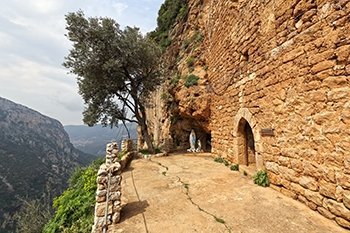
Site visited March 2019. Qadisha Valley was the site that I looked forward the most in Lebanon after Baalbek. And it didn’t disappoint my expectations. During my hike I visited three out of four of the main monasteries of the valley and saw some spectacular sceneries. In this review I focus only on the Qadisha Valley, not on the Cedars of God.
The dramatic and rugged Qadisha Valley is one of the oldest and most important early Christian monastic settlements. Valley formed a natural rampart which sheltered these early monastic communities. Maronite hermits found refuge in a multitude of almost inaccessible caves and rock-cut monasteries. Around these shelters the monks and hermits had turned the slopes into terraces to grow grain, grapes and olives.
This is one of the World Heritage Sites that are best experienced by foot. That is because many of the most interesting monasteries, churches and caves are located on the slopes of the valley that are not reachable by car. Hiking is also the best way to enjoy the great views and nature around you.
It was quite clear that I wanted to visit Qadisha Valley by hiking. At first I thought about independent hiking option but I found it too difficult. Distances are quite big and I couldn’t find good enough map of hiking routes. Private hiking tours are very expensive. The only alternative was to participate a group tour. I’m not really a group tour kind of traveller but I can bear it if itinerary is interesting. There are lots of Qadisha Valley tours available but they all have exactly the same itinerary with obligatory visit to Khalil Gibran museum which is not of interest to me. Fortunately I found a group hike arranged by Living Lebanon which matched my days and it was also reasonably priced. And it proved to be a good one.
Our hike started with a steep descent from the village of Hawqa to the Saydet Hawqa or Monastery of Our Lady of Hawqa. On that first section the views were absolutely spectacular. After 40 minutes we were at the monastery which is located on a cliff-side on an altitude of 1150 metres. The monastery is on lower level of a huge cave. On the upper level of the cave is a natural fortress of Aassi Hawqa which needs rock climbing skills to access. Hawqa Monastery was maybe the most interesting single site on my visit to Qadisha Valley. It is worth mentioning that in the monastery lives an 85 years old Maronite monk. He is originally Colombian but has lived in this small monastery for 20 years. After a short wait the grey bearded man showed up but he was not in a talkative mood.
We continued downwards along the edge of the gorge towards valley floor. After an hour we reached the Deir Qannoubine or Qannoubine Monastery. Founded in 375, it is the oldest of the Maronite monasteries and the first center of eremitic life in Lebanon. From 1440 to 1830 it was the See of Maronite Patriarch. As all the monasteries in Qadisha Valley it is partially cut into a rock. Maybe the most memorable thing in Qannoubine was the interior of the church with some nice frescoes which have remained almost intact since the 17th century.
Just before Qannoubine Monastery we visited the small Chapel of Mar Marina. It was not very impressive place – quite new building on top of an old cave – but to this site is associated a legend of a female saint Marina which is well known character in Lebanon.
Our hike ended at the Deir Mar Lichaa or Monastery of Mar Elisha which has been one of the most important monasteries of the valley and a place where the Maronite Order of Lebanese Monks was founded. Monastery of Mar Lichaa has been recently renovated and converted to a museum. I didn’t find it very interesting but it is certainly worth a quick visit.
After five hours and some 10 kilometres of hiking I was very content of the tour although in the end we got caught in the rain showers and hailstorm. In some places the cliffs are full of holes like cheese. It would have been interesting to visit also some smaller caves and churches off the main path. Qadisha Valley is a large WHS with numerous ancient buildings but also a place of magnificent landscapes and natural values and as such it deserves some time to explore.
More on
Comments
No comments yet.
